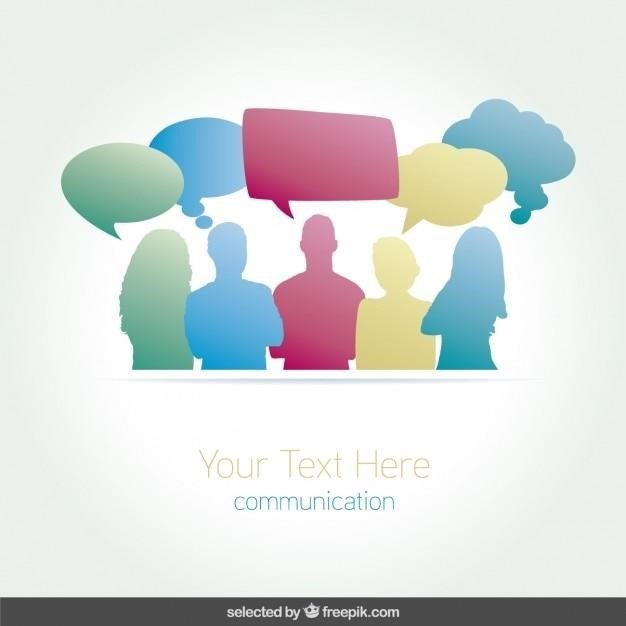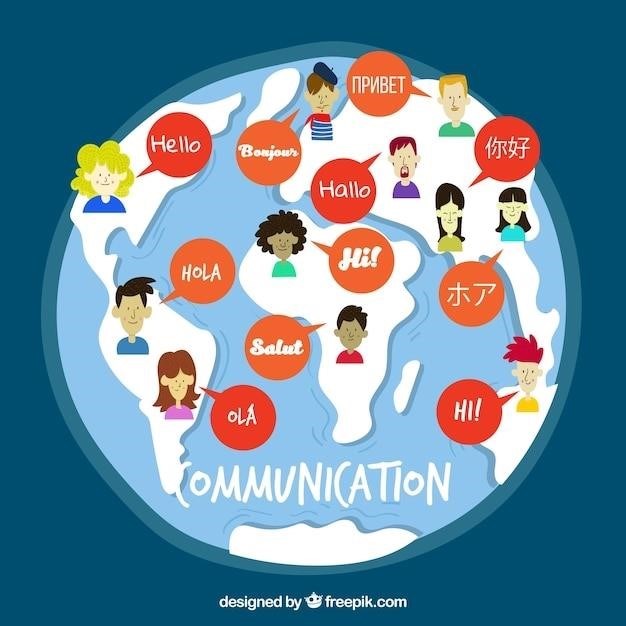Human Communication in Society⁚ 6th Edition
The 6th edition of “Human Communication in Society” is a widely used textbook for undergraduate courses, offering an updated and comprehensive exploration of communication theory and its application to real-life situations. The book is available in digital and print formats, and its content covers a broad range of topics, from communication models and theories to the influence of individual, societal, cultural, and contextual forces on communication.

Overview
“Human Communication in Society⁚ 6th Edition” is a comprehensive textbook that delves into the multifaceted nature of human communication within a societal context. This updated edition provides a thorough exploration of communication theory, models, and applications, highlighting their relevance to navigating the complexities of modern society. The book emphasizes the dynamic interplay between individual and societal forces, cultural influences, and the changing landscape of communication in the digital age. It aims to equip students with critical thinking and communication skills that are essential for effective interaction in a diverse and evolving world.
Key Features of the 6th Edition
The 6th edition of “Human Communication in Society” incorporates several key features that enhance its relevance and pedagogical value. It features updated examples, case studies, and research to reflect contemporary issues in communication, ensuring that students engage with current trends and challenges. The book also incorporates a diverse range of voices and perspectives, recognizing the importance of inclusivity and representation in communication studies. Furthermore, it emphasizes critical thinking and communication skills development, equipping students with the tools they need to navigate the complexities of modern communication landscapes.
Digital and Print Versions
The 6th edition of “Human Communication in Society” is available in both digital and print formats, catering to the diverse needs of students and instructors. The digital version, often referred to as an eTextbook, offers a range of interactive features designed to enhance learning, including enhanced search capabilities, highlighting and note-taking tools, flashcards for knowledge testing, and audio playback for listening to the text. The Pearson eTextbook platform provides a user-friendly interface for accessing and utilizing these features. The print version offers a traditional reading experience, and its physical format can be preferred by some students. Both versions provide access to the same comprehensive content, allowing students to choose the format that best suits their learning preferences and access needs.
Availability and Access

“Human Communication in Society⁚ 6th Edition” is widely available through various channels, both online and offline. Students can purchase the textbook through traditional bookstores, online retailers like Amazon, and educational platforms such as RedShelf. The textbook is also available for rental, providing a cost-effective option for students. For digital access, the eTextbook is available through Pearson’s platform, offering a subscription-based model. The availability of both print and digital versions ensures that students have multiple options to acquire and access the textbook, catering to their individual preferences and financial constraints. Additionally, the textbook’s ISBNs, 9781259833526 and 1259833526 for the digital version, and 9780078036958 and 007803695X for the print version, facilitate easy identification and purchase.
Content and Coverage
The 6th edition of “Human Communication in Society” offers a comprehensive and engaging exploration of human communication, providing a balanced blend of theoretical frameworks and practical applications. The textbook covers a wide array of topics, including communication models and theories, the influence of individual and societal forces on communication, cultural and contextual influences, and communication challenges in the modern world. It delves into the complexities of interpersonal communication, group dynamics, and mass media, examining how these various forms of communication shape our understanding of the world and our interactions with others. The content is presented in a clear and accessible manner, making it suitable for undergraduate students seeking to develop a foundational understanding of human communication.
Communication Models and Theories
The 6th edition delves into the foundational concepts of communication theory, providing a thorough examination of various models and frameworks used to understand how communication operates. These models offer a structured approach to analyzing communication processes, highlighting key elements such as sender, receiver, message, channel, noise, and feedback. The book explores classic models, such as the linear model and the transactional model, alongside contemporary perspectives, including the synergetic model. By examining these models, students gain a deeper understanding of the complexities involved in communication, including the impact of individual and societal forces, cultural and contextual influences, and the dynamic nature of communication as an ongoing process. This exploration of communication models and theories equips students with the analytical tools necessary to critically evaluate communication in diverse contexts.
Influence of Individual and Societal Forces
The 6th edition of “Human Communication in Society” recognizes the intricate interplay between individual characteristics and societal forces in shaping communication. The book explores how factors such as personality, beliefs, values, and experiences influence individual communication styles and choices. Furthermore, it delves into the influence of social structures, norms, and institutions on communication practices. The authors highlight how societal forces, including cultural expectations, gender roles, socioeconomic status, and political ideologies, can shape communication patterns and impact communication outcomes. By analyzing these influences, students develop a nuanced understanding of how communication is not simply a personal act but is also deeply embedded within social contexts. This exploration empowers students to navigate the complexities of communication in a diverse and interconnected world, fostering awareness of both individual and societal influences on communication.
Cultural and Contextual Influences
The 6th edition of “Human Communication in Society” emphasizes the profound impact of culture and context on communication. The book examines how cultural values, beliefs, norms, and traditions shape communication styles, message interpretation, and interaction patterns. It explores the influence of various cultural dimensions, including individualism versus collectivism, high versus low context cultures, and power distance, on communication practices. The text also delves into the role of context, including physical setting, social situation, and relationship dynamics, in shaping communication choices. By understanding the interplay of culture and context, students gain insights into the diverse ways in which communication operates across different cultures and situations. This knowledge equips them to communicate effectively and respectfully in a globalized world, fostering intercultural understanding and sensitivity.
Communication Challenges in the Modern World
The 6th edition of “Human Communication in Society” addresses the communication challenges that emerge in the contemporary world, where technology, globalization, and social change create a complex and ever-evolving communication landscape. The text examines the impact of social media and digital platforms on interpersonal and public communication, exploring the challenges of online identity management, cyberbullying, and the spread of misinformation. It also delves into the complexities of intercultural communication in a globalized world, highlighting the need for sensitivity, respect, and effective intercultural communication strategies. The book further analyzes the challenges posed by political polarization, cultural differences, and ethical dilemmas in online communication, emphasizing the importance of critical thinking, media literacy, and responsible communication practices in navigating these challenges.
Applications of Communication Theory
The 6th edition of “Human Communication in Society” goes beyond theoretical frameworks to demonstrate the practical applications of communication theory in various contexts. The book explores how communication principles can be applied to enhance interpersonal relationships, improve public speaking and presentation skills, navigate organizational communication, and effectively engage in conflict resolution. It highlights the role of communication theory in understanding media effects, analyzing political discourse, and promoting social change. Students will learn how to utilize communication strategies to build strong relationships, advocate for their beliefs, and effectively communicate in diverse settings. The text emphasizes the relevance of communication theory for navigating personal and professional challenges, fostering effective communication practices, and contributing to a more informed and engaged society.
Updated Content and Research
The 6th edition of “Human Communication in Society” reflects the dynamic nature of the communication field by incorporating updated content and research findings. The authors have carefully integrated new perspectives on emerging communication technologies, social media trends, and the impact of globalization on communication practices. The text explores the evolving landscape of digital communication, including the influence of social media platforms, online communities, and virtual reality on interpersonal relationships, social movements, and political discourse. Additionally, it addresses the ethical considerations and challenges associated with new communication technologies, fostering critical thinking about the responsible use of digital media. The updated research and examples ensure that students gain insights into contemporary communication phenomena and develop a deeper understanding of the complexities of communication in the modern world.
Use of Case Studies and Examples
The 6th edition of “Human Communication in Society” utilizes a rich array of case studies and real-world examples to bring communication theory to life. These illustrative scenarios provide students with practical applications of the concepts presented throughout the text. The authors carefully select case studies that are relevant to contemporary issues and challenges, such as the impact of social media on political campaigns, the complexities of intercultural communication in a globalized world, and the ethical dilemmas posed by online communication. The inclusion of diverse case studies, ranging from personal experiences to high-profile events, helps students make connections between theoretical frameworks and their own lives. By grounding theoretical concepts in real-world situations, the text fosters a deeper understanding of communication dynamics and encourages students to apply their knowledge to their own communication practices.
Critical Thinking and Communication Skills
The 6th edition of “Human Communication in Society” emphasizes the development of critical thinking and communication skills, recognizing their paramount importance in navigating the complexities of modern society. The text encourages students to analyze and evaluate communication processes, identify biases, and critically assess information sources. Through engaging activities and exercises, students are challenged to apply their understanding of communication theory to real-world scenarios, fostering a nuanced approach to communication. The book equips students with the skills necessary to become effective and ethical communicators, enabling them to navigate the ever-evolving landscape of communication in the digital age. These skills are essential for success in personal, professional, and academic settings, empowering students to engage thoughtfully and effectively in a diverse and interconnected world.
“Human Communication in Society” 6th edition stands as a valuable resource for students seeking to deepen their understanding of communication theory and its practical application in various contexts. The book’s balanced approach, encompassing both theoretical frameworks and real-world examples, provides a robust foundation for students to develop critical thinking and communication skills essential for navigating the complexities of modern society. The 6th edition incorporates updated content, including the impact of the COVID-19 pandemic on communication, reflecting the dynamic nature of the field. Through its engaging presentation and emphasis on critical analysis, “Human Communication in Society” empowers students to become more effective and ethical communicators, prepared to navigate the challenges and opportunities of a globally interconnected world.



